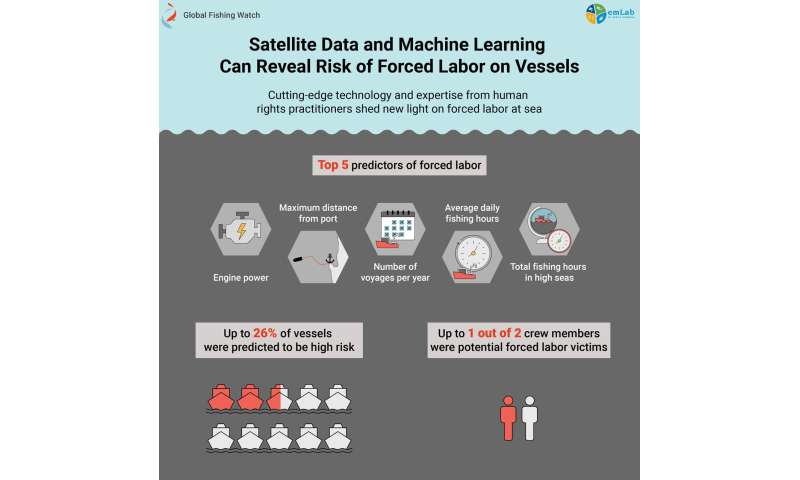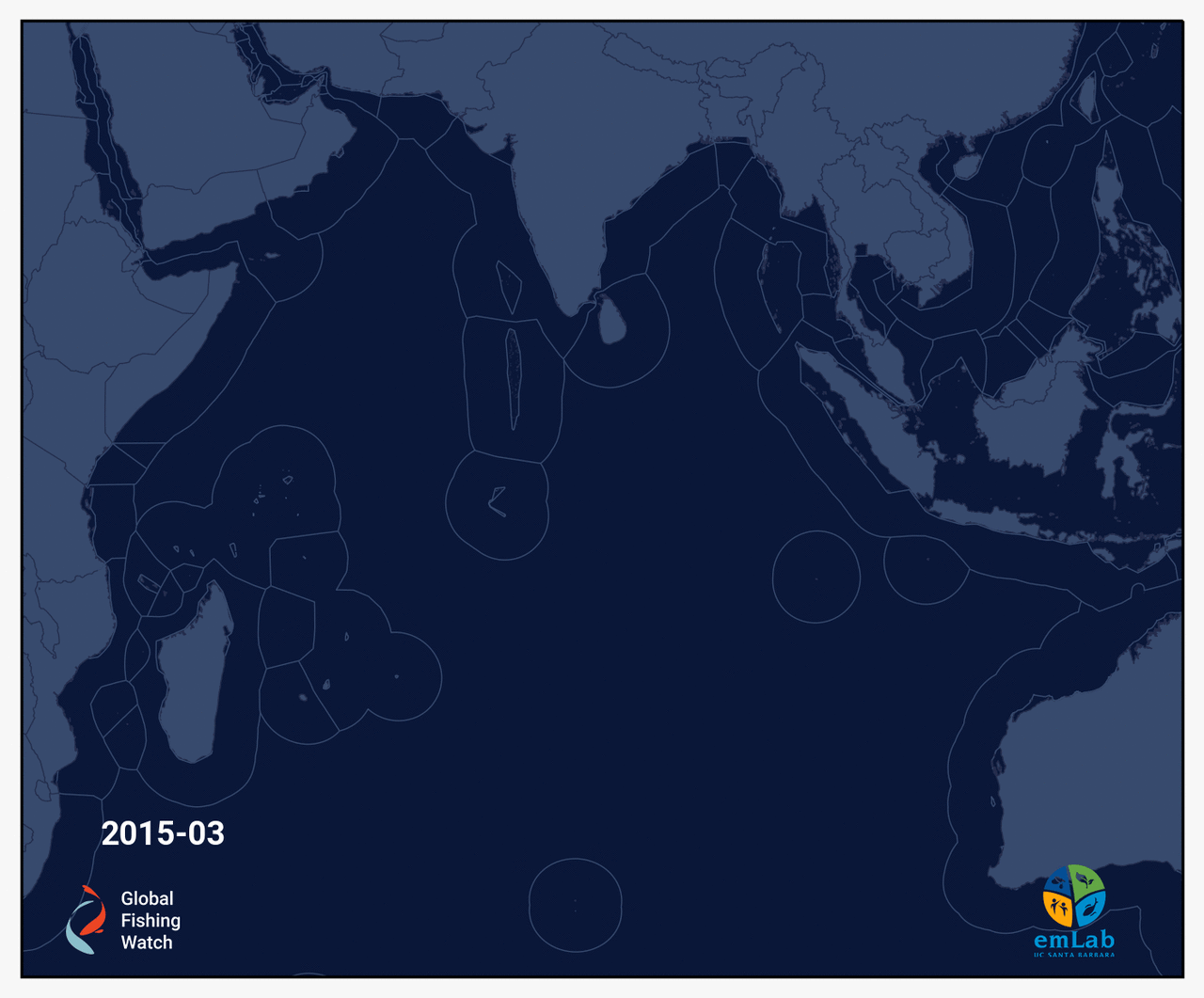https://phys.org/news/2020-12-satellites-reveal-labor-world-fishing.html
Percentage of 2018 fishing effort (in kilowatt-hours) made by model-identified high-risk vessels out of the total fishing effort by all vessels included in the model, using baseline assumptions, within the longliner, squid-jigger, and trawler fleets. Fishing effort is calculated for 0.5 × 0.5 ° latitude/longitude gridded bins, and areas with no forced labor risk are shown in black.
Credit: Global Fishing Watch
Vessels known to have crew that are subject to forced labor behave in systematically different ways to the rest of the global fishing fleet, reveals a new paper published today in the scientific journal, Proceedings of the National Academy of Sciences. The discovery was used to build a first-of-its-kind model to identify and predict vessels at high risk of engaging in these abuses.
The study found that up to 26 percent of the approximately 16,000 industrial fishing vessels analyzed were at high risk of using forced labor, a type of modern slavery. As many as 100,000 individuals are estimated to work on these high-risk vessels, many of whom are potential victims of forced labor. The study also shows where these high-risk vessels fished and the ports they visited.
"For several years now, international media has shone a spotlight on forced labor in the world's fishing fleet, but its extent has been largely unknown," said Gavin McDonald, project researcher at the Environmental Markets Solutions Lab, University of California, Santa Barbara (UCSB) and lead author on the study. "By combining satellite data, machine learning and on-the-ground expertise from human rights practitioners, we have identified vessels with a high risk of engaging in human rights abuses. Our findings can be used to unleash new policy and market actions that have not previously been possible."
The research team compiled 27 different vessel behaviors and characteristics that might indicate forced labor on board and can be observed using Global Fishing Watch's satellite vessel monitoring data.
Machine learning techniques were applied to a database of approximately 16,000 longline, squid jigger and trawler vessels to build the predictive model that can discriminate between high and low risk vessels. The database includes 22 vessels that have previously been publicly identified by news agencies and NGOs to have labor abuses on board. The study assessed the reported vessels against risk indicators defined by the International Labour Organization (ILO) and determined they were highly likely to have engaged in forced labor.

Cutting-edge technology and expertise from human rights practitioners shed new light on forced labor at sea Credit: Global Fishing Watch
Looking at annual behavior across the 16,000 vessels from 2012-2018, the model correctly predicted forced labor in more than 90 percent of reported high-risk activity and discovered as many as 4,200 new high-risk vessels.
The study found the most important indicators for distinguishing high-risk vessels include traveling farther from ports, higher engine power, more fishing hours per day, more time spent fishing on the high seas, and fewer fishing voyages in a given year than other boats.
"Global Fishing Watch uses satellite technology and machine learning to monitor industrial fishing vessels at sea; this study shows we can apply the same technologies to gain a better view into what is happening on deck," said David Kroodsma, research director at Global Fishing Watch and co-author on the study.
"The study represents a new frontier in our ability to shed light not only on whether vessel operators are fishing responsibly, but also the likelihood that they are treating their crew fairly."
Longliners had the largest total number of high-risk vessels. But when looking at the prevalence of high-risk vessels within fleets—squid jiggers had the highest percentage of high-risk vessels, followed closely by longline fishing vessels and then, to a far lesser extent, trawlers. High-risk longliners were found to be operating globally, whereas areas to the west and southeast of South America, the southeast of Russia and to the west of India were found to be hotspots for high-risk squid jiggers.
High-risk vessels visited ports predominantly in Africa, Asia and South America, although exceptions include Canada, New Zealand, the United States, and several European countries. These high-risk vessels visited ports in 79 countries in 2018, including 39 countries that are Parties to the FAO Port State Measures Agreement, a treaty aimed at tackling illegal, unreported and unregulated fishing through the enhancement of port State control. These ports are both potential sources of forced labor as well as transfer points for seafood caught using forced labor.
Longliners had the largest total number of high-risk vessels. But when looking at the prevalence of high-risk vessels within fleets—squid jiggers had the highest percentage of high-risk vessels, followed closely by longline fishing vessels and then, to a far lesser extent, trawlers. High-risk longliners were found to be operating globally, whereas areas to the west and southeast of South America, the southeast of Russia and to the west of India were found to be hotspots for high-risk squid jiggers.
High-risk vessels visited ports predominantly in Africa, Asia and South America, although exceptions include Canada, New Zealand, the United States, and several European countries. These high-risk vessels visited ports in 79 countries in 2018, including 39 countries that are Parties to the FAO Port State Measures Agreement, a treaty aimed at tackling illegal, unreported and unregulated fishing through the enhancement of port State control. These ports are both potential sources of forced labor as well as transfer points for seafood caught using forced labor.

Example vessel tracks showcase some of the top five predictors of forced labor on board, namely maximum distance from port, more average daily fishing hours, and more total fishing hours on the high seas.
Credit: Global Fishing Watch
Squid jiggers and longliners flagged to China, and longliners flagged to the Republic of Korea, Japan and the fishing entity of Taiwan were most frequently found to be high risk.
"By continuing this research and further drilling down to specific indicators, we can improve our ability to analyze patterns of vessel behavior that can detect illegal activity, such as forced labor at sea. This ability to zero in on bad actors is a potential game-changer for human rights organizations and enforcement agencies worldwide." said Valerie Farabee, director of research and analysis at Liberty Shared and co-author on the study.
UCSB and Global Fishing Watch aim to further develop this model to provide governments, enforcement bodies, and international agencies with a robust tool that can be used to assess risk of forced labor on vessels and support targeted inspections through relevant policy mechanisms. A forced labor risk tool may also be useful to the seafood sector and market-based programs when they conduct supply chain risk assessments, helping to incentivize improved working conditions.
"Global Fishing Watch and UCSB's forced labor model and research highlight ways that technology and machine learning can provide transparency and help focus interventions and resources more effectively for regulators and industry. This research is an important step and demonstrates both a smart approach and strong potential to drive more targeted action," said Chelsea Scantlan at the Walmart Foundation and funder of the study.
Forced labor, restriction of movement, debt bondage, and poor working conditions, are increasingly recognized as part of a human rights crisis in the fisheries sector. The ILO estimates that 16 million people were victims of forced labor in 2016, with 11 percent in agriculture, forestry and fisheries.
Recommend this post and follow The birth of
modern Man
https://disqus.com/home/forum/lifeofearth/


No comments:
Post a Comment
Stick to the subject, NO religion, or Party politics